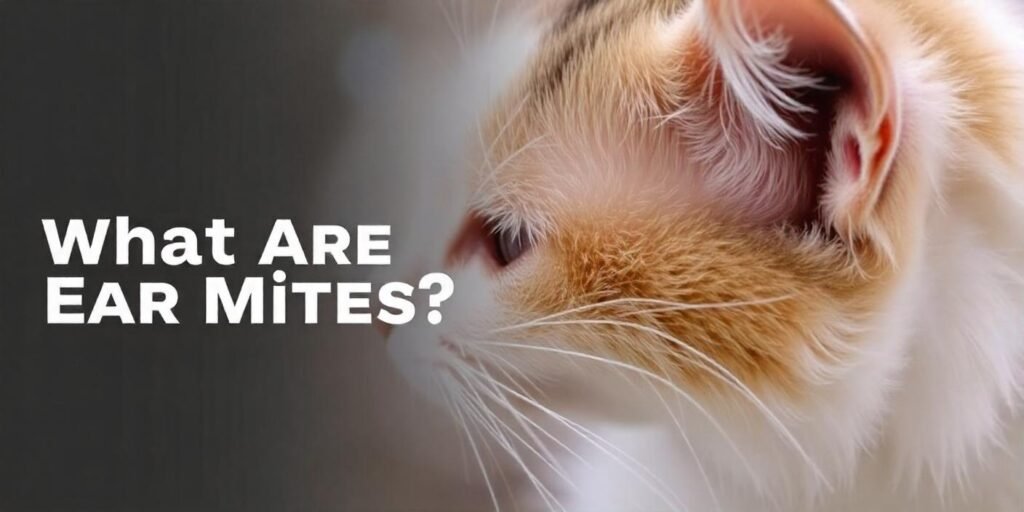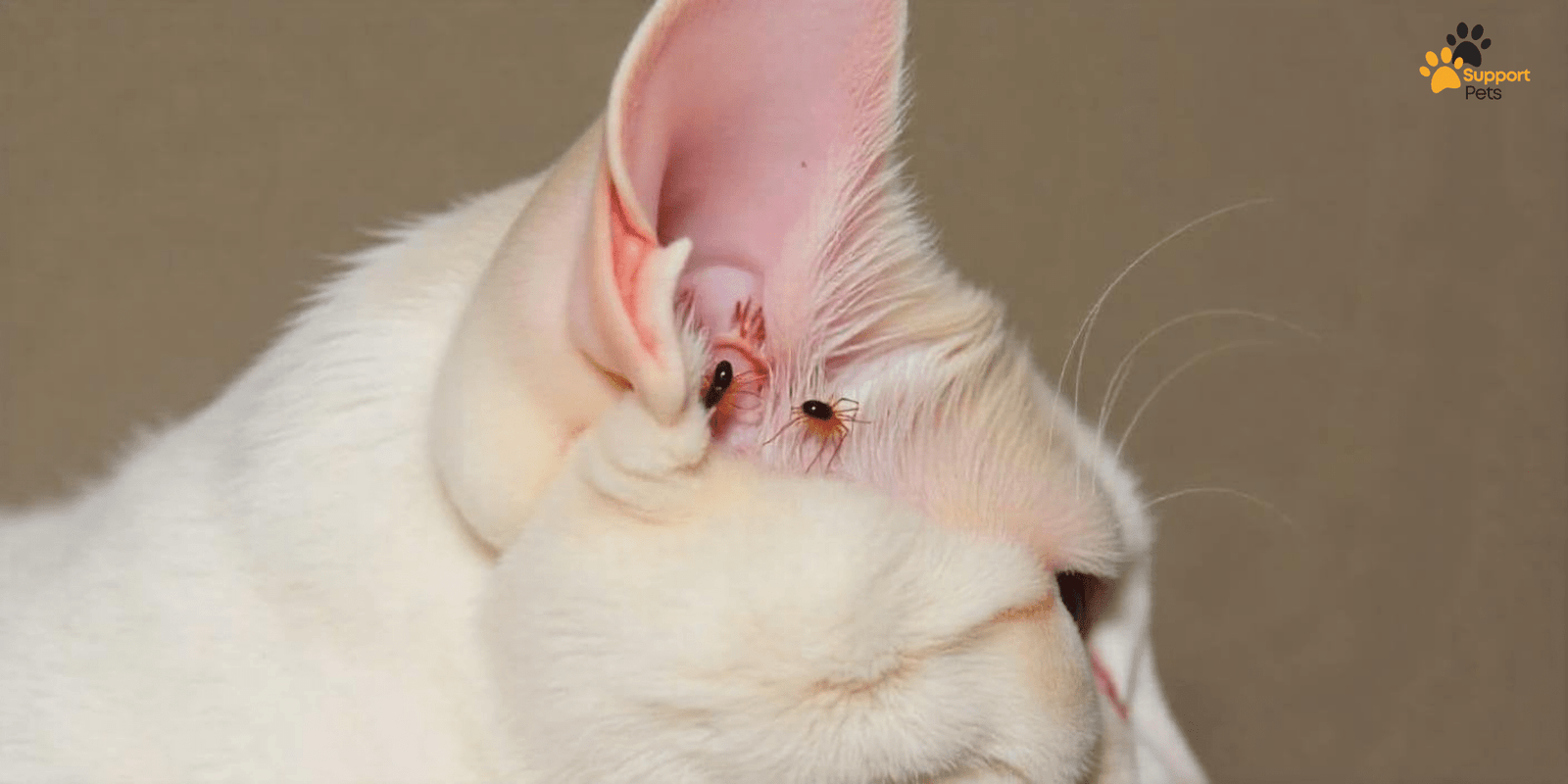Ear mites are a common parasitic issue in cats. These tiny pests cause discomfort and can lead to infections if untreated. Cats of all breeds, including black Maine coons and grey tabby cats, can suffer from this issue. Detecting and treating ear mites early is crucial to your pet’s health. In this article, we’ll explore symptoms, treatments, and related care tips.
What Are Ear Mites?

Ear mites are microscopic parasites that live in a cat’s ear canal. They feed on earwax and oils, causing irritation and inflammation. The most common type is Otodectes cynotis. These mites are highly contagious and can spread from one pet to another. Early detection is important to prevent serious ear infections.
Symptoms of Ear Mites in Cats
Common symptoms of ear mites include excessive scratching, head shaking, and dark discharge from the ears. Cats may also tilt their heads frequently. If you notice these signs, it’s important to consult a vet. Ear mites can cause severe discomfort and, if left untreated, lead to more serious problems like infections.
Diagnosis and Treatment
A veterinarian will examine your cat’s ears and may use an otoscope to confirm the presence of mites. Treatment typically involves ear drops or topical medications designed to kill the mites. Regular cleaning of your cat’s ears is essential during treatment to remove debris and prevent further infection. According to PetMD, following your vet’s instructions is critical for complete recovery Mites Affect Different Cat Breeds
While ear mites can affect any breed, some cats may be more prone to ear infections, which could worsen the condition. Black Maine coons, for instance, have dense fur that may trap moisture and debris, making them more susceptible to mites. Grey tabby cats, with their sleek coats, may not face the same risk, but they are still vulnerable to infestation.
Ear Mites in Black Maine Coons
Black Maine coons are particularly vulnerable to ear mites due to their thick fur and large ears. Their dense coats can make it harder for owners to spot early signs of infestation. Regular grooming and ear checks are crucial. Maine coons are also known for their laid-back nature, so changes in behavior might be subtle.
Grey Tabby Cats and Ear Mites
Grey tabby cats are no exception when it comes to ear mite infestations. Though they have shorter fur than Maine coons, their ears can still harbor mites. Regular ear cleaning and vet check-ups are important to catch infestations early. Watch for any signs of irritation or changes in behavior.
Prevention and Care for Cats with Ear Mites

Prevention is key when it comes to ear mites. Keeping your cat’s ears clean can reduce the risk of infestation. Use a vet-recommended ear cleaner to gently wipe away wax and debris. For breeds like black Maine coons, extra attention may be needed due to their fur density. Ensure regular grooming to keep mites at bay.
Grooming Tips for Long-Haired Cats
Long-haired cats like black Maine coons need special grooming care. Brush their fur regularly to remove dirt and debris that could lead to mite infestations. Pay extra attention to their ears during grooming sessions. For grey tabby cats, regular ear checks and cleaning are just as important.
The Role of Diet in Ear Health
A healthy diet can support your cat’s overall immune system, making them less susceptible to ear mites. Salty licorice cats, known for their unique fur color and patterns, require a balanced diet rich in vitamins and minerals. Feeding your cat high-quality food can contribute to better ear health and overall well-being.
Read More: Shiloh Shepherd
How to Prevent Ear Mites from Spreading

Since ear mites are highly contagious, it’s important to prevent them from spreading to other pets. If one of your pets has ear mites, separate them from others until they’ve been treated. Clean bedding, toys, and areas where your cat frequently spends time. For multi-pet households, regular vet visits are crucial to keeping everyone healthy.
Cleaning and Disinfecting Your Home
Disinfecting your home can prevent the recurrence of ear mites. Wash your cat’s bedding, blankets, and toys in hot water. Use pet-safe disinfectants to clean their living areas. If you have a black Maine coon or grey tabby cat, focus on areas they frequent, as mites can transfer easily.
Can Ear Mites Affect Humans?
Although rare, ear mites can occasionally transfer to humans. They cannot live on human skin for long, but they may cause mild irritation. It’s important to clean your home thoroughly and wash your hands after handling an infected pet. Regular handwashing and cleanliness can prevent the spread of ear mites to humans.
When to Visit a Vet

If your cat shows signs of ear mites, it’s important to visit a vet for diagnosis and treatment. Vets can provide the best treatment options, such as ear drops or medication. Left untreated, ear mites can lead to more severe ear infections, which may require more extensive care. Regular vet checkups help prevent infections from becoming serious.
Follow-Up Care for Ear Mites
After treatment, it’s essential to follow up with your vet to ensure the mites are completely gone. Regular ear cleaning and monitoring will prevent a re-infestation. For cats like black Maine coons and grey tabby cats, regular grooming will help keep their ears mite-free. Keeping an eye on their behavior will also help detect any signs of discomfort.
FAQS
Prescription ear mite treatments, such as Ivermectin or selamectin, can kill ear mites in cats instantly. Consult your veterinarian for the best option.
To treat ear mites in cats, use veterinarian-prescribed ear drops, topical medications, or oral treatments, along with proper cleaning of the ears.
To get rid of ear mites in cats, use a vet-recommended ear mite treatment and thoroughly clean your cat’s ears to eliminate debris and mites.
Treat ear mites in cats with topical or oral medications prescribed by a vet, and clean the affected ears regularly to reduce mites and prevent reinfestation.
Check for ear mites in cats by looking for excessive scratching, dark debris in the ears, and a strong, unpleasant odor. A vet can confirm the presence with a microscope.
Conclusion: Protecting Your Cat from Ear Mites
Ear mites are a common issue for cats, but with early detection and proper care, they can be easily treated. Regular vet checkups, proper grooming, and a balanced diet are key to keeping your cat healthy. Whether you own a black Maine coon, a grey tabby cat, or a salty licorice cat, prevention is always better than cure. By staying vigilant and providing proper care, you can ensure your feline friend stays comfortable and healthy.










